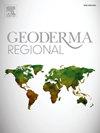Assessing the morphological, physicochemical, and mineralogical properties of black soils and ferralsols and identification of potential risk of degradations along a climotoposequence in Foumbot, West Cameroon
IF 3.3
2区 农林科学
Q2 SOIL SCIENCE
引用次数: 0
Abstract
Foumbot in Cameroon is renowned for its fertile soils, which serves as a food basket for the region. However, these soils are currently under threat due to climate change and overutilization. As such, there is a need to better understand their properties, variability and identify the degradation risks to improve their management and conservation. To address this gap, soil profiles formed under volcanic deposits were sampled at three distinct altitudes: 1156 m (highland), 1075 m (middle land), and 974 m (lowland), representing tropical highland, transitioning tropical highland, and tropical forest climates, respectively. Physical and chemical analyses, X-ray diffraction (XRD) and Fourier-Transform Infrared (FTIR) techniques, were conducted to determine the variability of soil morphology, physical and chemical properties, and mineralogy as well as soil classification under climotoposequence. The findings reveal that pedon 1 in the highland was dark in colors (2.5Y and 10YR), slightly acidic to neutral and exhibited the highest organic carbon content (6.8 %) in the surface horizon. In contrast, the middle land, showed a slightly acidic profile (pedon 2) characterized by a darker surface horizon (10YR) with a yellowish subsoil (7.5YR) and lower organic content (4.1 %) in surface horizon compared to pedon 1. Finally, the lowland profile (pedon 3), displayed more acidic conditions and the lowest soil organic carbon content (2.5 %) in surface horizon compared to pedon 1 and pedon 2. A trend of decreasing Alo + ½Feo and Alp/Alo alongside increasing clay content was observed with decreasing altitude. Mineralogical analysis revealed a transition from short-range ordered minerals (allophane and ferrihydrite) in highland soils to poor crystalline kaolinite dominance in the middle land and well crystalline kaolinite in lowland. Additionally, bulk density increased with decreasing altitude. According to the WRB classification, Pedon 1 was classified as Mollic Vytric Silandic Andosol (Loamic, Eutrosilic, Humic), Pedon 2 as Dystric Xanthic Andic Ferralsol (Clayic, Humic), and Pedon 3 as Umbric Rhodic Ferralsol (Clayic, Humic). Andosol was identified as black soil and presents greater potential for agricultural productivity compared to the two other pedons. Since andosols are situated at the top of the hill, possess structural weaknesses (granular structure), and are subjected to intensive cultivation, they pose a higher potential risk of degradation when farming is practiced compared to the other two pedons. This study highlights the significant influence of pedogenetic factors on the soil properties and mineral composition and reveals the urgent need of adopting new soils sustainable management strategies to protect black soils in the Foumbot region of Cameroon.
评估喀麦隆西部Foumbot地区黑土和铁砂的形态、物理化学和矿物学特性,并确定沿气候序列退化的潜在风险
喀麦隆的Foumbot以其肥沃的土壤而闻名,这是该地区的食物篮子。然而,由于气候变化和过度利用,这些土壤目前正受到威胁。因此,有必要更好地了解它们的特性和可变性,并确定退化风险,以改善它们的管理和保护。为了解决这一差距,火山沉积物下形成的土壤剖面在三个不同的海拔高度进行了采样:1156米(高原)、1075米(中部)和974米(低地),分别代表热带高原、过渡热带高原和热带森林气候。通过理化分析、x射线衍射(XRD)和傅里叶变换红外(FTIR)技术,确定了气候序列下土壤形态、理化性质、矿物学和土壤分类的变化。结果表明,高岭土1的颜色较深(2.5Y和10YR),呈微酸性至中性,有机碳含量最高(6.8%)。而中部地区则呈现微酸性剖面(壤壤2),壤壤层深(10YR),底土淡黄(7.5YR),有机质含量较壤壤1低(4.1%)。低剖面(土墩3)与土墩1和土墩2相比,地表酸性条件更强,土壤有机碳含量最低(2.5%)。随着海拔的降低,随着粘土含量的增加,Alo +½Feo和Alp/Alo呈下降趋势。矿物学分析表明,高原土壤由近程有序矿物(铁矾和铁水合石)为主转变为中部以低晶高岭石为主,中部以低晶高岭石为主。此外,堆积密度随海拔的降低而增加。根据WRB分类,Pedon 1属Mollic Vytric silandandosol (loic, Eutrosilic, Humic), Pedon 2属dystriic Xanthic - Ferralsol (clay, Humic), Pedon 3属Umbric Rhodic Ferralsol (clay, Humic)。安多索尔被确定为黑土,与其他两个培土相比,具有更大的农业生产力潜力。由于固溶土位于山顶,具有结构缺陷(颗粒状结构),并且需要集约耕作,因此与其他两种土壤相比,它们在耕作时具有更高的潜在退化风险。本研究强调了成土因素对土壤性质和矿物组成的显著影响,揭示了采取新的土壤可持续管理策略来保护喀麦隆Foumbot地区黑土的迫切需要。
本文章由计算机程序翻译,如有差异,请以英文原文为准。
求助全文
约1分钟内获得全文
求助全文
来源期刊

Geoderma Regional
Agricultural and Biological Sciences-Soil Science
CiteScore
6.10
自引率
7.30%
发文量
122
审稿时长
76 days
期刊介绍:
Global issues require studies and solutions on national and regional levels. Geoderma Regional focuses on studies that increase understanding and advance our scientific knowledge of soils in all regions of the world. The journal embraces every aspect of soil science and welcomes reviews of regional progress.
 求助内容:
求助内容: 应助结果提醒方式:
应助结果提醒方式:


